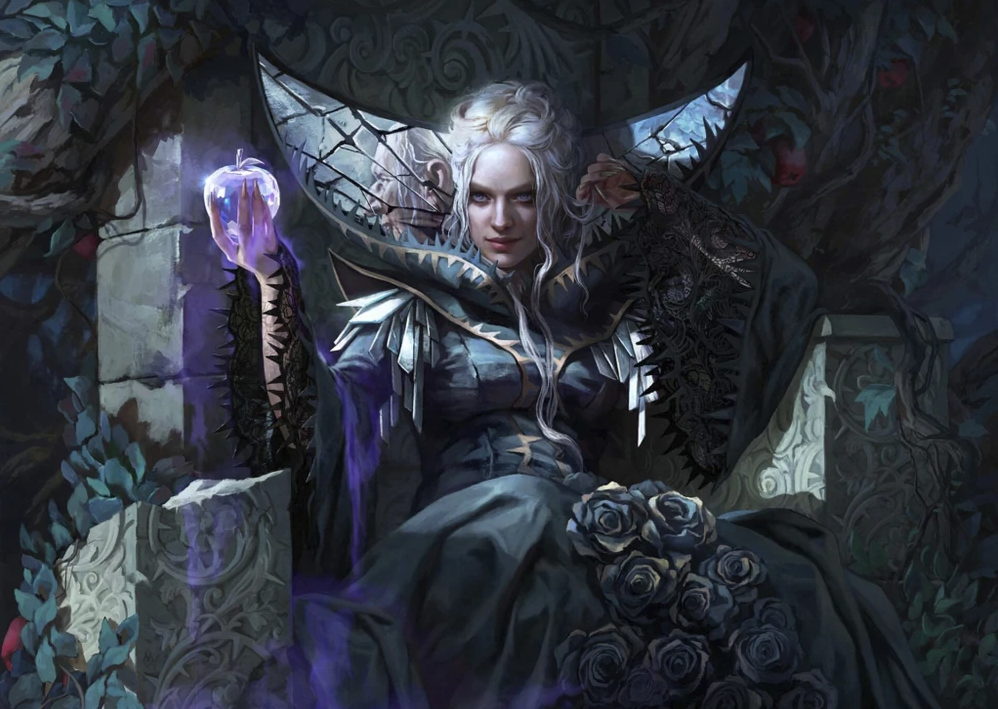Folklore and Fairytales in the Wilds of Eldraine

(Eriette of the Charmed Apple | Art by Magali Villeneuve)
Magic: The Gathering has a long history of making myth manifest - from minotaurs to werewolves to vampires to dinosaur pirates. Wilds of Eldraine is no different, taking us by the hand back into the magical storybook world of Eldraine to explore even further.
You'd be forgiven for first thinking of Disney princesses if someone were to say the phrase "fairy tale" to you, but the history of fairy tales is longer and darker than you might imagine. Even beyond the famous Brothers Grimm and their gory retellings of folk stories in the 1700s and 1800s (I don't remember any Disney version of a huntsman disembowelling a wolf to free Little Red Riding Hood and her Grandma, or Flynn Rider in Tangled falling into a thornbush and getting blinded), some of the most famous folklore stretches back even further. Cinderella has her roots in Ancient Greek tales from around 7 BCE! So, what is it about fairy tales that has kept us coming back for literally thousands of years, and why are they the perfect setting for us to return to in Wilds of Eldraine?
One of the reasons that fairy tales are so enduring and popular is because they are so simple in their premise. This simplicity means that they are immediately recognisable, adaptable, and marketable - there is even an index by which folklorists categorise fairy tales based on the archetypes and identifiable characters they include. So, what does this have to do with Magic: The Gathering (MTG)? Well, let's think about the lore of Wilds of Eldraine - we have witches three, a Big Bad (welcome back, Ashiok!), a once beautiful land under an evil spell, magical creatures, and two plucky underdog siblings trying to save and protect their homeland through sword and sorcery. Sound familiar?
Just like in fairy tales, everyone in Wilds of Eldraine has a set role to play or archetype to fulfil. In the most literal fulfilment of fairy tale archetypes, Wilds of Eldraine sees the introduction of Aura Role enchantment tokens, allowing players to equip one character per player at a time with a Role. You can decide their place in the story, be it a Monster or a Young Hero.
Other thematic mechanics throughout Wilds of Eldraine continue to lean into the myth and magic of fairy tales in tangible and interactive ways, pulling threads from stories and weaving them into a whole new fairy tale landscape. Now more than ever it seems, the colour and card archetypes in Wilds of Eldraine are perfectly matched to the lore of the set, and to the history of fairy tales more generally. A Titanic Growth
Hansel and Gretel and the Gingerbread Man really step into the spotlight in this set, with the reintroduction of a popular older mechanic and theme - Food. Food artifacts and the abundance of food in the set more generally, with monstrous candy creatures and candy trails to gallant Syr Ginger herself, tie deliciously into folkloric inspirations. Food is always an evocative and personal subject, which is why it appears so often in fairy tales. Everyone eats, and food represents safety, comfort, and nurturing, so dangerous or cursed food has long been a staple of the darker sides of folklore. Poisoned apples have a long and biblical history, and sweet treats have been used as a tricksy reward system for kids for centuries. Wilds of Eldraine reminds us that even though we may be hundreds of years away from the origins of the original foodie fairy tales, the fears that plagued the audiences in the past are still just as disconcerting today, no matter how we re-tell them.
Card art is just as iconic as game mechanics in MTG; Wilds of Eldraine leans heavily into its fairytale roots to explore different stylistic choices. The variety in art style speaks not only to the history of MTG itself, but to the evolution of fairy tale illustration and art, too. Thousands of years of stories have led to thousands of art styles. In the 1600s when fairy tales were printed across Europe in inexpensive chapbooks, cheap and easy woodcut prints would be used to pick out important moments from the story to highlight the most exciting or dramatic parts of the tale. In much the same way, Wilds of Eldraine, and indeed any Magic: The Gathering set, uses Story Spotlight cards to highlight elements of the established storyline that can be retold and adapted in every game.
With such a variety in card types, Wilds of Eldraine makes the most of exploring the huge variety of historic interpretations of fairy tales. Throughout the set we see tapestry-like sagas and William Morris-esque tokens, mirroring the transformation that fairy tales and their art underwent as their popularity continued to grow and their audiences changed throughout history. From the humble woodcuts, artwork within fairy tales moved into the 1920s with art nouveau inspired designs, then to the watercolour and pencil designs that we might associate with the children's books, before moving to the modern animation and CGI of the big screen.
After all, enduring adaptability is the really magical thing about fairy tales, and it's exactly why they work so well in the context of Magic: The Gathering. Every time we retell a fairy tale or play a game of commander, we change the ending somehow...be it adapting a story to speak to a cultural shift, or using a different creature or instant to combat an opponent. Whatever we do with these tales and these cards, we can be sure that just like fairy tales throughout time, the moral of the story persists, but the way we tell it is entirely up to us.